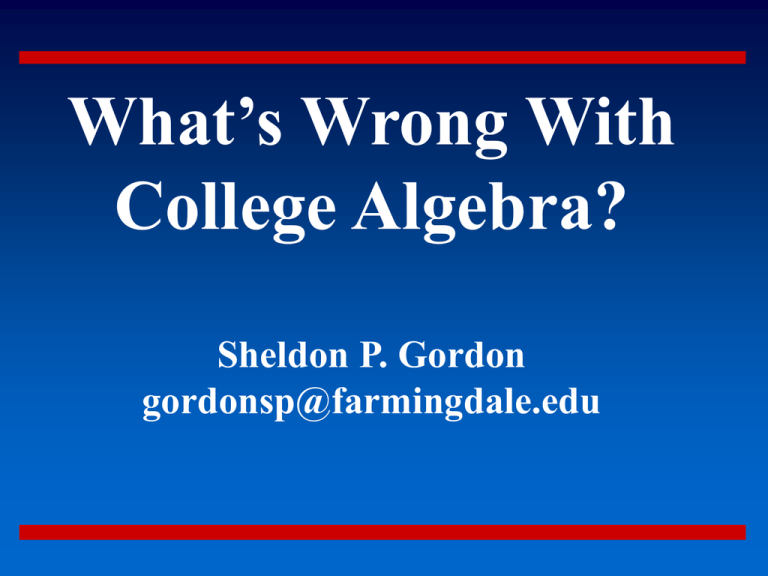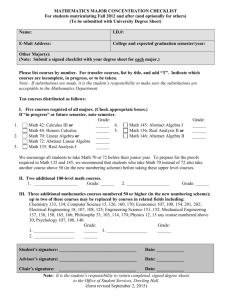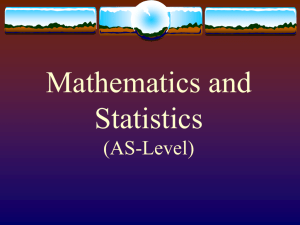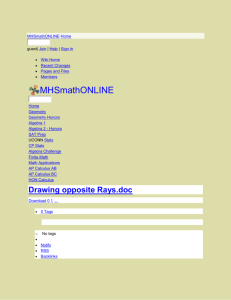Refocusing the Courses Below Calculus
advertisement

What’s Wrong With College Algebra? Sheldon P. Gordon gordonsp@farmingdale.edu College Algebra and Precalculus In 2000, between 1,000,000 and 2,000,000 students took college algebra and precalculus courses At most schools, these are the bread-andbutter courses – huge numbers of students and very cheap to run (staffed usually by TA’s or part-time faculty). College Algebra and Precalculus The focus in most of these courses is on preparing the students for calculus. But only a very small percentage ever go on to start calculus. Enrollment Flows Based on several studies of enrollment flows from college algebra to calculus: • Only about 5% of the students who take college algebra courses ever start Calculus I • The typical DFW rate in college algebra is typically well above 50% • Virtually none of the students who pass college algebra courses ever start Calculus III • Perhaps 30-40% of the students who pass precalculus courses ever start Calculus I Why Students Take These Courses Required by other departments • Satisfy general education requirements • To prepare for calculus • For the love of mathematics Four Special Invited Conferences • Rethinking the Preparation for Calculus • Reforming College Algebra • CRAFTY Curriculum Foundations Project • Forum on Quantitative Literacy Common Recommendations “College Algebra” courses should be real-world problem based: Every topic should be introduced through a real-world problem and then the mathematics necessary to solve the problem is developed. Common Recommendations A primary emphasis in “College Algebra” should be Mathematical Modeling: – transforming a real-world problem into mathematics using linear, exponential and power functions, systems of equations, graphing, or difference equations – using the model to answer problems in context – interpreting the results and changing the model if needed. Common Recommendations “College Algebra” courses should emphasize communication skills: reading, writing, presenting, and listening. These skills are needed on the job and for effective citizenship as well as in academia “College Algebra” courses should emphasize small group projects involving inquiry and inference. Common Recommendations “College Algebra” courses should make appropriate use of technology to enhance conceptual understanding, visualization, and inquiry, as well as for computation “College Algebra” courses should be student centered rather than instructor centered pedagogy: they should include hands-on activities rather than all lecture Important Volumes • CUPM Curriculum Guide: Undergraduate Programs and Courses in the Mathematical Sciences, MAA Reports. • Ganter, Susan and Bill Barker, Eds., A Collective Vision: Voices of the Partner Disciplines, MAA Reports. • Madison, Bernie and Lynn Steen, Eds., Quantitative Literacy: Why Numeracy Matters for Schools and Colleges, National Council on Education and the Disciplines, Princeton • Baxter-Hastings, Nancy, Sheldon Gordon, Florence Gordon and Jack Narayan, Eds., A Fresh Start for Collegiate Mathematics: Rethinking the Courses Below Calculus, MAA Notes. CUPM Curriculum Guide 2004 • All students, those for whom the (introductory mathematics) course is terminal and those for whom it serves as a springboard, need to learn to think effectively, quantitatively and logically. • Students must learn with understanding, focusing on relatively few concepts but treating them in depth. Treating ideas in depth includes presenting each concept from multiple points of view and in progressively more sophisticated contexts. CUPM Curriculum Guide 2004 • A study of these (disciplinary) reports and the textbooks and curricula of courses in other disciplines shows that the algorithmic skills that are the focus of computational college algebra courses are much less important than understanding the underlying concepts. • Students who are preparing to study calculus need to develop conceptual understanding as well as computational skills. AMATYC Crossroads Standards In general, emphasis on the meaning and use of mathematical ideas must increase, and attention to rote manipulation must decrease. •Faculty should include fewer topics but cover them in greater depth, with greater understanding, and with more flexibility. Such an approach will enable students to adapt to new situations. •Areas that should receive increased attention include the conceptual understanding of mathematical ideas. NCTM Standards These recommendations are clearly very much in the same spirit as the recommendations in NCTM’s Principles and Standards for School Mathematics. If implemented at the college level, they would establish a smooth transition between school and college mathematics. Some Conclusions We cannot simply concentrate on teaching the mathematical techniques that the students need. It is as least as important to stress conceptual understanding and the meaning of the mathematics. We can accomplish this by using a combination of realistic and conceptual examples, homework problems, and test problems that force students to think and explain, not just manipulate symbols. If we fail to do this, we are not adequately preparing our students for successive mathematics courses, for courses in other disciplines, and for using mathematics on the job and throughout their lives. Further Implications If we focus only on manipulative skills without developing conceptual understanding, we will produce nothing more than students who are only Imperfect Organic Clones of a TI-89 Curriculum Foundations Project A series of 11 workshops with leading educators from 17 quantitative disciplines to inform the mathematics community of the current mathematical needs of each discipline. The results are summarized in the MAA Reports volume: A Collective Vision: Voices of the Partner Disciplines, edited by Susan Ganter and Bill Barker. Curriculum Foundations Project The discussions and recommendations of virtually every other discipline focused on the mathematics below calculus. Even such mathematically intense fields as physics offer far more non-calculus based courses than calculus-based courses. The Common Themes • Strong emphasis on problem solving • Strong emphasis on realistic applications and mathematical modeling • Conceptual understanding is more important that skill development • Development of critical thinking and reasoning skills is essential The Common Themes • Use of technology, especially spreadsheets • Development of communication skills (written and oral) • Greater emphasis on probability and statistics • Greater cooperation between mathematics and the other disciplines Some Implications Although the number of college students taking calculus is holding steady, the percentage of students taking college calculus is dropping, since overall college enrollment has been rising rapidly. But the number of students taking calculus in high school already exceeds the number taking it in college. It is growing at 8%. Some Implications Few, if any, math departments can exist based solely on offerings for math and related majors. Whether we like it or not, mathematics is a service department at almost all institutions. And college algebra and related courses exist almost exclusively to serve the needs of other disciplines. Some Implications If we fail to offer courses that meet the needs of the students in the other disciplines, those departments will increasingly drop the requirements for math courses. This is already starting to happen in engineering. Math departments may well end up offering little beyond developmental algebra courses that serve little purpose. What is Quantitative Literacy? Quantitative literacy (QL), or numeracy, is the knowledge and habits of mind needed to understand and use quantitative measures and inferences necessary to function as a responsible citizen, productive worker, and discerning consumer. QL describes the quantitative reasoning capabilities required of citizens in today's information age -- from the QL Forum White Paper QL and the Mathematics Curriculum The focus of the math curriculum is the geometry-algebra-trigonometry-calculus sequence. • • • • • In high school, the route to competitive colleges. The sequence is linear and hurried. No time to teach mathematics in contexts. Courses are routes to somewhere else. Other sequences are terminal and often second rate. How does the US compare to other countries? Many College Graduates Demonstrate Weak Quantitative Literacy Skills Grads: 2 Yr. Colleges Grads: 4 Yr. Colleges Level 5: High 5 13 Level 4 30 40 Level 3 44 40 Level 2 17 10 Level 1: Low 4 3 Source: USDOE, NCES, National Adult Literacy Survey, 1992, in Literacy in the Labor Force: Results from the NALS, September 1999, p. 61. The Forum on Quantitative Literacy Participants were top-level representatives of business, industry, and government, and very few academics. The discussions focused on the broad need of every educated person to have a significantly higher level of quantitative understanding and skills. The recommendations were amazingly similar to those mentioned previously. Where Does College Algebra Fit In? QL is something that should permeate the entire mathematics curriculum, so that every student develops this knowledge and skills. The one existing course that provides the best opportunity to stress QL is college algebra: • It has the largest enrollment • It does not prepare or motivate large numbers of students to go on to calculus • It is taken to prepare students for courses in other disciplines, and the themes of QL are the mathematical topics needed in most other disciplines today. What Can Be Removed? How many of you remember that there used to be something called the Law of Tangents? What happened to this universal law? Did triangles stop obeying it? Does anyone miss it? What Can Be Removed? • Descartes’ rule of signs • The rational root theorem • Synthetic division • The Cotangent, Secant, and Cosecant were needed for computational purposes; Just learn and teach a new identity: 1 tan x 2 1 cos2 x How Important Are Rational Functions? • In DE: To find closed-form solutions for several differential equations, (usually done with CAS today, if at all) • In Calculus II: Integration using partial fractions–often all four exhaustive (and exhausting) cases • In Calculus I: Differentiating rational functions • In Precalculus: Emphasis on the behavior of all kinds of rational functions and even partial fraction decompositions • In College Algebra: Addition, subtraction, multiplication, division and especially reduction of complex fractional expressions In each course, it is the topic that separates the men from the boys! But, can you name any realistic applications that involve rational functions? Why do we need them in excess? Realistic Applications and Mathematical Modeling • Real-world data enables the integration of data analysis concepts with the development of mathematical concepts and methods • Realistic applications illustrate that data arise in a variety of contexts • Realistic applications and genuine data can increase students’ interest in and motivation for studying mathematics • Realistic applications link the mathematics to what students see in and need to know for other courses in other disciplines.





